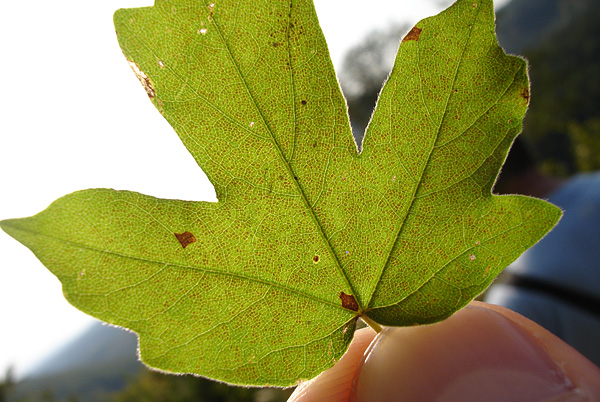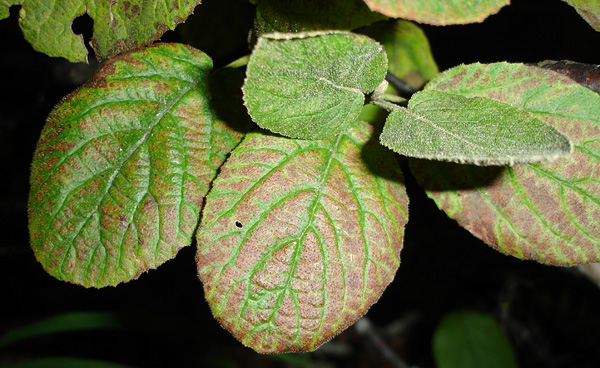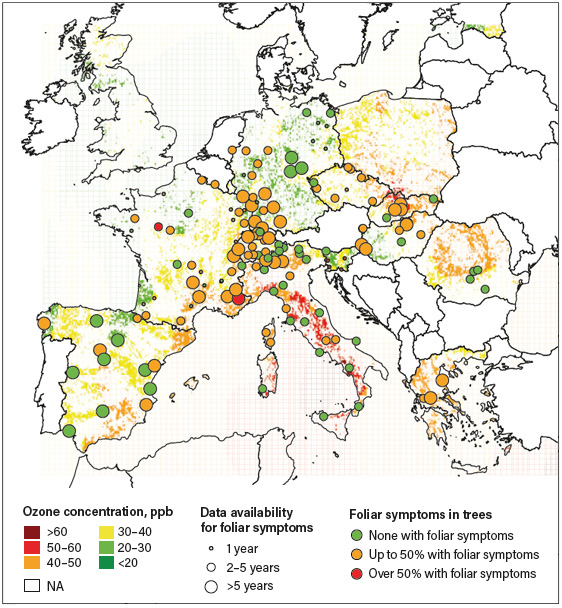ICP Forests is a European-wide network of forest sites to study the effects of air pollutants on forests. Scientists have been measuring ozone concentrations since 2000 on 233 research sites in 18 countries and have observed a small but statistically significant decrease of mean summer concentrations. Southern Switzerland, however, remains one of the regions with the highest ozone levels in Europe; areas in Northern Europe are less affected.
The aggressive pollutant causes visible symptoms on leaves and needles on many sites of the ICP Forests monitoring network. The symptom development depends on the species and how well the trees are supplied with water, light and nutrients. Ozone may affect tree growth and water metabolism, and contributes to degradation of forests and their important services: these include provision of clean air and groundwater, timber for construction and energy, protection against natural hazards and of biodiversity.

Fig. 1 - Visible ozone symptoms on a field maple leaf (Acer campestre). The darkdots represent collapsed cells, whose cell walls have been oxidized by ozone.
Photo: Marcus Schaub (WSL)

Fig. 2 - Leaves of the wayfaring tree (Viburnum lantana) with visible ozone symptoms.
Photo: Marcus Schaub (WSL)
Scientists of the Swiss Federal Research Institute WSL summarize these results in ICP Forests Brief No. 3. Their key messages are:
- Ozone is a gaseous air pollutant present in remote areas – due to long-distance transport of airborne pollutants – at levels causing visible symptoms in plants.
- Despite a significant reduction, ozone levels at ICP Forests sites still exceed the threshold value above which adverse effects can occur.
- Ozone-induced foliar symptoms have been observed on woody plant species all across Europe.
- Further observational and long-term monitoring studies are needed to better quantify dose-response relationships and a potential impact on forest growth.
Marked north-south gradient
The long-term mean ozone concentrations in the growing season (April–September) showed an increasing trend from north to south in forests across Europe for the period to (average: 36.2 ppb, ranging from 14.5 to 70.1 ppb). The highest concentrations occurred in Italy, southern Switzerland, the Czech Republic, Slovakia, Romania and Greece.
ICP Forests (International Co-operative Programme on Assessment and Monitoring of Air Pollution Effects on Forests) aims at a comprehensive compilation of information on the condition of forests in Europe and beyond. It was launched in 1985 and monitors forest condition in Europe at two monitoring intensity levels. The Level I monitoring is based on around 6000 observation plots throughout Europe and beyond to gain insight into the geographic and temporal variations in forest condition while the Level II intensive monitoring comprises around 500 plots in selected forest ecosystems with the aim to clarify cause-effect relationships. At present 42 countries participate in ICP Forests.

Fig. 3 - Spatial distribution of April–September mean ozone concentrations interpolated from 18’464 passive samplers on 206 plots in 15 countries for the period 2000–2014 (background colour) and occurrence of ozone-induced foliar symptoms on 155 plots in 11 countries for the period 2002–2014 (coloured dots). Source: ICP Forests Brief No 3
